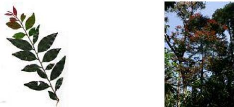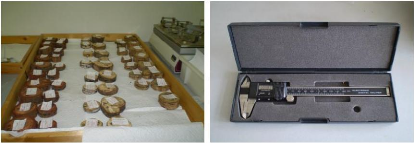3. MATERIAL AND METHODS
3.1 Studied plant species and collection of samples
This research aimed to establish the growth performance for
five tree species from four different wood species families (Table 1). The
Samples were collected in 2002 in the Comoé National Park (Côte
d'Ivoire, Hennenberg, 2005) and in Central Benin (Orthmann, 2005). At CNP, 10,
8 and 8 samples were respectively collected from D. microcarpum,
A. leiocarpa and D. abyssinica. A. leiocarpa was
collected at the forest border, D. microcarpum in the savanna and
D. abyssinica in the forest. In Benin, six (6) samples were also
collected from I. doka, P. erinaceus and A. leiocarpa
in open mosaic forest.
TABLE 1- The five tree species investigated
in two different sites. UAC: Upper Aguima catchment, CNP: Comoé National
Park; Cutting levels (level 1: cut at 0,1m - level 2: cut at 1,3m) and N (tree)
means the number of sampled trees.
|
Site
|
Species
|
Family
|
Foliation
pattern
|
N
(tree)
|
Cutting
levels
|
|
CNP
|
Anogeissus leiocarpa (DC.) Guill. & Perr.
|
Combretaceae
|
Short deciduous
|
8
|
1-2
|
|
UAC
|
Anogeissus leiocarpa (DC.) Guill. & Perr.
|
Combretaceae
|
Short deciduous
|
6
|
1
|
|
CNP
|
Detarium microcarpum Guill & Perr.
|
Caesalpiniaceae
|
Deciduous
|
10
|
1-2
|
|
CNP
|
Diospyros abyssinica (Hiern) F. White
|
Ebenaceae
|
Evergreen
|
8
|
1-2
|
|
UAC
|
Isoberlinia doka Craib and Stapf
|
Caesalpiniaceae
|
Brevi-deciduous
|
6
|
1-2
|
|
UAC
|
Pterocarpus erinaceus Poir.
|
Fabaceae
|
Pronounced deciduous
|
6
|
1
|
The african birch species named Anogeissus leiocarpa
(DC.) Guill. & Perr., belong to the family of Combretaceae and ranged
from the borders of the sahara up to the outlier humid tropical forests and is
found from Senegal to Cameroon in West Africa. The tree of about 20 m of height
with light green foliage grows in dry forest s, fringing forests and semi aris
savanna areas. The leaves, bark, roots and seeds serve for traditional tanning
and its wood is used for house construction and tool handles because of its
resistance against insects (Seed leaflet, 2007). The picture 1 shows some of
morphological characteristics of the species.

1a 1b 1c
Picture 1: Morphological characteristics of
Anogeissus leiocarpa
Picture 1a: Flowers - Picture 1b: aspect of the stem - Picture
1c: the tree (Brunken et al., 2008)
Detarium microcarpum Guill. & Perr. from
the family of Caesalpiniaceae typically found in high rainfall savanna areas,
dry forests and fallow land, on sandy or iron rich hard soils. It can grow up
from 10 m to 25 m in height. D. Microcarpum tree is also found in open
savanna as a more stunded tree with smaller fruits as showing the picture 2. It
has great fruit-bearing potential and is also used as medicinal plant.

2a 2b 2c
Picture 2: Morphological characteristics of
Detarium microcarpum
Picture 2a: the fruits - Picture 2b: the aspect of the bark -
Picture 2c: the tree (Brunken et al., 2008)
Diospyros abyssinica (Hiern) F. White has small,
medium or large tree up to 36 m with a
relatively sparse and shortly
branched crown. The leaves are altern ate, glossy dark green and
distinctly
red when they are young. Its ecological distribution is known as widespread
in
tropical Africa from the Guinea Republic to Eritrea southwards
to the FZ area an d Angola. It is known for its medicinal use and used to make
pestles. The picture 3 shows at left the leaves and at right its trees in
forest stand.

3a 3b
Picture 3: Morphological characteristics of
Diospyros abyssinica Picture 3a: a leave - Picture 3b: the tree
(Brunken et al., 2008)
Isoberlinia doka Craib Stapf is one of several
sudanian species of the family of Caesalpiniaceae found in deciduous woodland,
tall grass savanna alway s in stands forming open forests with Isoberlinia
tomentosa, Burkea africana, Prosopis africana, Uapaca somon etc... The
tree has 10 to 20 m of height and the trunk straight 5 m height. The wood is
used in marine construction, naval architecture, in paper products, as pulpwood
and for office materials. The aspect of the foliage is presented in figure
4.

4a 4b
Picture 4: Morphological characteristics of
Isoberlinia doka
Picture 4a: the fruits - Picture 4b: the aspect of the bark
(Brunken et al., 2008)
Pterocarpus erinaceus is a tropical African deciduous
tree of 12 to 15 m (or more) that can be found in open stands, woodland and
savanna. The bark is fissured as showing the picture 5.
Its wood is useful for house construction, in carpentry for doors
and windows frames. It makes very good charchoal and decorative things.

5a 5b 5c
Picture 5: Morphological characteristics of
Pterocarpus erinaceus
Picture 5a: the fruits - Picture 5b: the aspect of the bark -
Picture 5c: the tree (Brunken et al., 2008)
The dendrometric measurements such as diameter at 10 cm from
grou nd, diameter at breast height (DBH) and the total height were made on some
of the sampled trees by Orthmann (2005) and Hennenberg (2005). Their mean
values were presented in table 2. The cross-sectional wood discs were cutted at
10 cm from ground level and at breast height (DBH) for all tree samples from
Ivory Coast. In Benin, at least one stem disc per tree was cutted.
TABLE 2- Some characteristics of the
investigated species. MD (1): mean diameter at 10 cm from ground, MD (2): mean
DBH, MNR: mean number of ring of samples cutted at 10 cm from ground, MH: mean
height and s.d: standard of deviation.
|
Species
|
N
(trees)
|
MD (1) #177; sd
(mm)
|
MD (2) #177; sd
(mm)
|
MNR
|
MH #177; sd
(m)
|
|
A. leiocarpa
(UAC)
|
6
|
44 #177; 1.41
|
|
6.33 #177; 0.82
|
1.8 #177; 0.00
|
|
A. leiocarpa
(CNP)
|
8
|
72.62 #177; 4.14
|
52.12 #177; 1.81
|
17 #177; 1.41
|
6.77 #177; 0.52
|
|
D. microcarpum
|
10
|
79.5 #177; 10.01
|
52.1 #177; 1.29
|
13.4 #177; 2.12
|
3.47 #177; 0.32
|
|
D. abyssinica
|
8
|
76.62 #177; 12.45
|
52.75 #177; 2.12
|
30.25 #177; 2.55
|
7.00 #177; 0.71
|
|
I. doka
|
6
|
55.25 #177; 7.91
|
42.44 #177; 3.50
|
7.83 #177; 2.40
|
2.77 #177; 0.55
|
|
P. erinaceus
|
5
|
42.93 #177; 2.96
|
|
8.2 #177; 1.09
|
2.14 #177; 0.22
|
The stem discs were labelled and conducted in laboratory
(University of Göttingen, Germany). It is useful to note that the most of
Comoé National Park samples were really cutted at two levels of height
(10 cm from ground and 1.3 m). The missing diameter values were added after
measurements on these stem discs with electronic forest compass (Pictures 6 and
7).

Picture 6: Some of the analysed stem discs
Picture 7: The used electronic forest compass
| 


